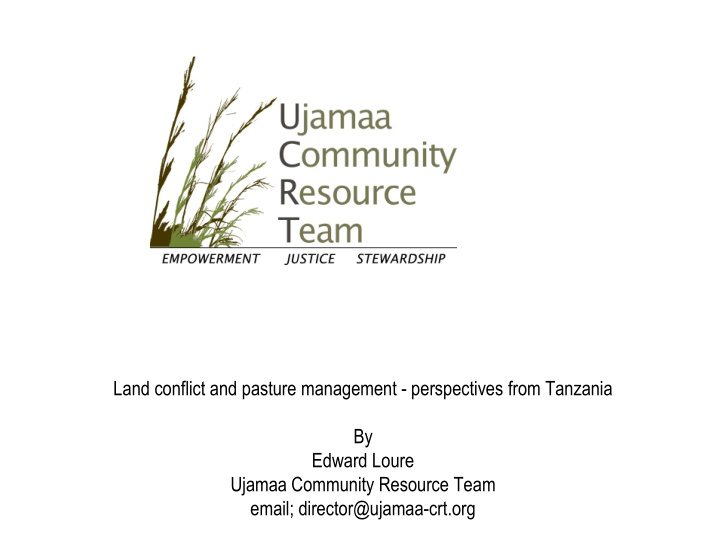



Land conflict and pasture management - perspectives from Tanzania By Edward Loure Ujamaa Community Resource Team email; director@ujamaa-crt.org
INTRODUCTION • The pastoralist community who live in Ngorongoro District, Loliondo Division, which borders the east of the Serengeti National Park and Maasai Mara Game Reserve in Kenya to the north. The community was living in Serengeti National Park before being evicted in the 1950s. The Maasai economy is based on livestock keeping and the communal management of extensive rangelands; they do not hunt wildlife or consume wild meat, making their system of production compatible with the local wildlife populations and the wider ecosystem. • The Maasai communities who border National Parks depend on their relationship with nature and face severe threats to their livelihoods and existence. The communities have faced and continue to face pressure over loss of their lands from several types of protected or conservation areas; these include national park, conservation areas (Ngorongoro) and concessions given by the Government for tourist hunting. Some have been evicted from their common lands and denied access to pasture and water which is essential for their survival.
Land conflict through conservation and hunting investment • Since 1980s a wave of land grabbers have invaded areas of Loliondo in Northern Tanzania. Being a wildlife corridor in between Serengeti National Park in Tanzania and Maasai Mara in Kenya, and at the same time due to sudden policy changes in the 1980s promoting commercial investments, the area became a zone of land use conflicts. • In 2012, 4 years after the mass eviction 2009, the government proposed alternative land Use Plan that aimed at creating the Wildlife Corridor of 1,500 Sq Km from the pastoral community land that will be used for exclusive hunting by Orttelo Business Cooperation (OBC). The plan was unanimously refused by the villagers, councilors and criticized heavily by the CSOs in Tanzania. • It should also be noted that, Serengeti, Tarangire, Lake Manyara, Arusha, Mkomazi national parks as well as Ngorongoro Conservation Area in Tanzania all of them were established in maasai pastoralists grazing areas that contribute to more than 30% of total national land area set aside for conservation purposes.
CONT… • The conflicts between local communities and government authorities over natural resources and community land uses, for pastoralists bordering national parks have been excluded from many of the benefits of grazing and other natural resources which are found within their environment. • The pastoralists’ land was used by different groups to create hunting blocks, large and small scale farming, which has decreased the land for pastoralists’ people, and many families were left without access to pasture and other resources. Outsiders occupied water sources, which provide water for both domestic and wildlife use. • As a result of land grabbing the pastoralists, culture and natural resources were exploited; the eviction of pastoralist people from their homeland, and violation of natural resources use rights. Loss of land and water and pasture use rights led to severe decrease of food availability per family. • The loss of village land 1500 Sq Km will affect more than 35,000 pastoralists from eight villages in Loliondo division Ngorongoro district. • • • • • • • • • •
Govt. Imposed land use plan2 map Loliondo
Village Participatory Land Use Plan • The work of UCRT has revolved around natural resource planning and the creation of supporting materials such as by-laws and maps. This process of village planning is in line with the national land use policy and the 1999 land act. The policy identified village land use as one of the criteria for villages to get land certificates from the ministry of land. • Other important objectives of land use plans are to enable villages to publicize the traditional way they use land and natural resources and how they allocate their optimal uses. The form of village land use is grounded in local knowledge of the landscape, which considers village economic benefits, social relationships and sustainable resources conservation. • Village Land Use Planning consists of identifying different land use categories and are formed by a participatory planning process with the approval from the village assembly.
Village Land Use Map
Community struggle toward the situation • Local communities in Loliondo strive to protect their remaining land, setting up participatory land use planning and approved governing by-laws. • NGOs and CSOs work with the aim to improve sustainable livelihoods and a healthy environment for pastoralists and other communities border national parks through sustainable pasture management. • UCRT advocate the position of the community having the rights to control, own and benefit from their land and natural resources so that people can improve their lives from their own resources.
Recommendations • The livelihoods of pastoralists who border national park are threatened by the name of conservation, investors and land grabbers. It’s a high time for CELEP to help us to lobby from TZ government to change policies and develop culture that gives the minority groups’ rights to own and benefits from their common pool resources and not otherwise. • Community and Local CSOs in the region to continue raise awareness for international lobbying bodies like CELEP and international media like AVAAZ and others. • We would like CELEP to help us in lobbying from TZ government authorities to do not harass Local NGOs who help in advocating for the community’s land versus improper investors in communities land.
THANK YOU! www.ujamaa-crt.org
Recommend
More recommend